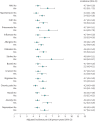Prevalence, incidence and characteristics of chronic cough among adults from the Canadian Longitudinal Study on Aging
- PMID: 34007841
- PMCID: PMC8093484
- DOI: 10.1183/23120541.00160-2021
Prevalence, incidence and characteristics of chronic cough among adults from the Canadian Longitudinal Study on Aging
Abstract
The global prevalence of chronic cough is highly variable, ranging from 2% to 18%. There is a lack of data on the prevalence and incidence of chronic cough in the general population. The objective of this study was to investigate the prevalence and incidence of chronic cough in a sample of Canadian adults, and how these are influenced by age, sex, smoking, respiratory symptoms, medical comorbidities and lung function. Participants with chronic cough were identified from the Canadian Longitudinal Study on Aging (CLSA) based on self-reported daily cough in the past 12 months. This is a prospective, nationally generalisable, stratified random sample of adults aged 45-85 years at baseline recruited between 2011 and 2015, and followed-up 3 years later. The prevalence and incidence per 100 person-years are described, with adjustments for age, sex and smoking. Of the 30 097 participants, 29 972 completed the chronic cough question at baseline and 26 701 did so at follow-up. The prevalence of chronic cough was 15.8% at baseline and 17.6% at follow-up with 10.4-17.1% variation across seven provinces included in the CLSA comprehensive sample. Prevalence increased with age and current smoking, and was higher in males (15.2%), Caucasians (14%) and those born in North America, Europe or Oceania (14%). The incidence of chronic cough adjusted for age, sex and smoking was higher in males and in underweight and obese subjects. Subjects with respiratory symptoms, airway diseases, lower forced expiratory volume in 1 s (% predicted), cardiovascular diseases, psychological disorders, diabetes and chronic pain had a higher incidence of chronic cough. The prevalence and incidence of chronic cough is high in the CLSA sample with geographic, ethnic and gender differences, influenced by a number of medical comorbidities.
Copyright ©The authors 2021.
Conflict of interest statement
Conflict of interest: I. Satia reports grants and personal fees from Merck during the conduct of the study; and personal fees for educational talks for general practitioners from GSK and AstraZeneca, grants and personal fees from Merck Canada, an ERS Respire 3 Marie Curie Fellowship and an E.J. Moran Campbell Early Career Award, outside the submitted work. Conflict of interest: A.J. Mayhew has nothing to disclose. Conflict of interest: N. Sohel has nothing to disclose. Conflict of interest: O. Kurmi has nothing to disclose. Conflict of interest: K.J. Killian has nothing to disclose. Conflict of interest: P.M. O'Byrne reports grants and personal fees from AstraZeneca and Medimmune, personal fees from GSK and Chiesi, and grants from Novartis, outside the submitted work. Conflict of interest: P. Raina has nothing to disclose.
Figures




Similar articles
-
Impact of mental health and personality traits on the incidence of chronic cough in the Canadian Longitudinal Study on Aging.ERJ Open Res. 2022 May 30;8(2):00119-2022. doi: 10.1183/23120541.00119-2022. eCollection 2022 Apr. ERJ Open Res. 2022. PMID: 35651367 Free PMC article.
-
Impact of productive and dry chronic cough on mortality in the Canadian Longitudinal Study on Aging (CLSA).J Thorac Dis. 2022 Dec;14(12):5087-5096. doi: 10.21037/jtd-22-1306. J Thorac Dis. 2022. PMID: 36647475 Free PMC article.
-
Burden of chronic cough on social participation, healthcare resource utilisation and activities of daily living in the Canadian Longitudinal Study on Aging (CLSA).Respir Med. 2023 Nov-Dec;219:107431. doi: 10.1016/j.rmed.2023.107431. Epub 2023 Oct 24. Respir Med. 2023. PMID: 37879447
-
Declining FEV1 and chronic productive cough in cigarette smokers: a 25-year prospective study of lung cancer incidence in Tecumseh, Michigan.Cancer Epidemiol Biomarkers Prev. 1994 Jun;3(4):289-98. Cancer Epidemiol Biomarkers Prev. 1994. PMID: 8061576
-
Worldwide prevalence, risk factors and burden of chronic cough in the general population: a narrative review.J Thorac Dis. 2023 Apr 28;15(4):2300-2313. doi: 10.21037/jtd-22-1435. Epub 2023 Apr 26. J Thorac Dis. 2023. PMID: 37197554 Free PMC article. Review.
Cited by
-
Impact of mental health and personality traits on the incidence of chronic cough in the Canadian Longitudinal Study on Aging.ERJ Open Res. 2022 May 30;8(2):00119-2022. doi: 10.1183/23120541.00119-2022. eCollection 2022 Apr. ERJ Open Res. 2022. PMID: 35651367 Free PMC article.
-
Living with chronic cough: experiences, burden and management in interstitial lung disease - a mixed methods study.ERJ Open Res. 2025 Feb 25;11(1):00641-2024. doi: 10.1183/23120541.00641-2024. eCollection 2025 Jan. ERJ Open Res. 2025. PMID: 40008164 Free PMC article.
-
Impact of high-risk of obstructive sleep apnea on chronic cough: data from the Korea National Health and Nutrition Examination Survey.BMC Pulm Med. 2022 Nov 16;22(1):419. doi: 10.1186/s12890-022-02222-5. BMC Pulm Med. 2022. PMID: 36384528 Free PMC article.
-
Prevalence of chronic cough, its risk factors and population attributable risk in the Burden of Obstructive Lung Disease (BOLD) study: a multinational cross-sectional study.EClinicalMedicine. 2024 Jan 21;68:102423. doi: 10.1016/j.eclinm.2024.102423. eCollection 2024 Feb. EClinicalMedicine. 2024. PMID: 38268532 Free PMC article.
-
Cough in the Elderly During the COVID-19 Pandemic.Lung. 2022 Apr;200(2):161-168. doi: 10.1007/s00408-022-00525-2. Epub 2022 Mar 17. Lung. 2022. PMID: 35298689 Free PMC article.
References
LinkOut - more resources
Full Text Sources
Other Literature Sources
Miscellaneous
